 |
 |
If somebody claimed to do something so amazing such as moving an object across a table with only using their thoughts, would you believe them? You would want them to prove their ability to you in a scientific experiment, wouldn't you? A scientific experiment designed to eliminate fraud. Unless they participated in this experiement and they were successful in proving their ability, they would always be false. Just because somebody says they can do something, doesn't make it fact. They need hard evidence to back up their claim.

With all these alleged psychics on late night television these days, I am inclined to say that they are all fraudulent. I am not saying that psychic abilities do not exist. If these people claim to be psychics, they have to prove themselves. And the same thing applies to both Creation and Evolution.

This page is designed in such a way that it gives both Evolution and Creation equal opportunities. The arguments I have on this web page are logical arguments which both Creation and Evolution have to answer. There are questions that either Creation or Evolution has no answers for. And it is this very fact which will disprove one or the other.
Building the Foundation
Creation implies a designer. A designer uses the process of Systems Analysis to accomplish an end result. It also states that all life did not go through an Evolutionary process. All life was created in its final form and each form procreates after his kind, hence, the gene is the unit of heredity.
The concept of creation is provable; we go through the four phases(Study, Design, Development, and Operation) of Systems Analysis to accomplish an end product. We study different ways to accomplish the best result and then we design it, build it, and put it into use.
Evolution implies either a designer wasn't needed for life to start or that the designer allows evolution to take place by design. It also reflects that there was an Evolutionary struggle(one form Morphing into another form) between the animals through Natural Selection.

The Evolutionary Transition Form
An important item within the theory of Evolution is a "transition form". A transition form is described as a median between two other forms. Transition forms must have a design which allows them to be competitive in nature, otherwise they will die.
1 2 3 4 5
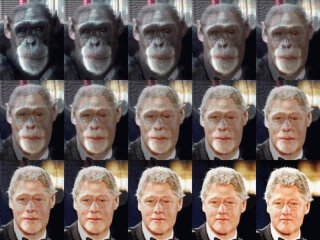
11 12 13 14 15As you look at the above picture, take note of the gradual changes from each transition form. Images are numbered from left to right starting at "1" in the upper left corner and going to "15" for the lower right picture and "8" being the center image. This is just an example of Evolution, to give you an idea of what we're dealing with here. It is humorous, but it serves me well. :-)
The above pictures were made using a "morphing" technique.
Where two initial images(the upper left(#1) and lower right(#15) pictures) are used to make fictitious "in-between" images. The 50/50 mix of picture #1 and #15 would be in the very center(#8).

Are Evolution and Creation logical with regards to speech?
In order for theory to be fact it must be logical. Logic is the foundation of function.
The usage of Creation in speech
When we have built something, we always say we "created" it. I have never heard anybody say, they "evolved" it. The usage of "Creation" within speech seems to be perfectly logical because it describes the steps we went through to accomplish the end result.(Systems Analysis) That is what Creation implies, Systems Analysis, a thinking process.
The usage of Evolution in speech
An example of the usage of the Evolutionary theory; Many people say the modern automobile evolved from a horse and buggy. In this scenario the horse and engine are the power source which makes the vehicle move. Evolution must produce something that is 50% horse and 50% metallic(the engine) in order to justify this argument. A transition form which is 50% horse and 50% metallic is illogical because such a thing would not live.
What the above paragraph successfully does is, it shows the illogistics in using the words "evolve" or "evolution" within speech. And nobody can argue with logic, can they? The same type of argument can be applied to other scenarios within speech as well. But this does not mean that Evolution is out of the running yet. Continue......

The Time Line
Evolution
Evolutionists claim that mankind has been evolving through millions of years. The only known writings we have are from the past 6,000 years. We have gone from writings on clay tablets to the space shuttle in just 6,000 years time. There is a big problem here; If man has been the same for the past 100,000 years, why has he not produced 100,000 years of writings, technology, cities, and all the rest?
This is where we see logicaly that Evolution has a BIG problem. Evolution does not fit in with history. Since it took the human race 6,000 years to accomplish the Space Shuttle from Clay Tablets, how more advanced would the human race be if this same 6,000 years was 100,000 years? A perfectly logical agrument which Evolution cannot answer.
Ancient stories all over the world credit the "gods" and not mankind for building many ancient structures all over the world. These structures also demonstrate an advanced knowledge of astronomy and building techniques that cannot be attributed to primitive man unless he had a spacecraft, such as planet Pluto.(Teotihuacan, Mexico. Teotihuacan means, "The place of the gods")
Creation
Human civilization suddenly pops up around 4,000BC. All known writings from the ancient world all support a creator being. You notice I do not even mention the Biblical record? I wish to leave the Bible out of this argument for now. One can use logic to disprove one or the other(Creation or Evolution).

Not one ancient civilization speaks of Evolution. In fact, they all tell similar creation stories then the biblical Adam & Eve, where man was made from mud, dirt or dust from the ground and fused together by a divine being. All these stories have common roots. If anybody should know about Evolution it's ancient peoples. They were the ones that were allegedly witnessing it happening for the past 100,000 years, right? These "evolving people" should have learned Evolution from their ancestors, but they didn't.

Random Chance
Evolution
Evolutionists claim that life started randomly. You learned from a previous chapter that random doesn't exist in this universe. How can evolutionists justify themselves in making the statement that life formed randomly, when all scenarios regarding physical matter within the universe are predetermined? DNA is physical matter.
Creation
DNA has three dimensional fractal geometry encoded within it, therefore it is predetermined. Random chance was not used in the design of DNA. All things within the universe were designed using mathematics.
Again we see a perfectly logical argument before us which Evolution does not fit.

Cro-Magnon Man
It is a known fact that Neanderthals met a sudden extinction and were replaced by human beings(Cro Magnon Man). Evolution isn't this fast. It is supposed to take place through millions of years.
Several scientists have came out with their own studies that state Neanderthals are not related to human beings. We already know that ancient Sumerian clay tablets reflect this.
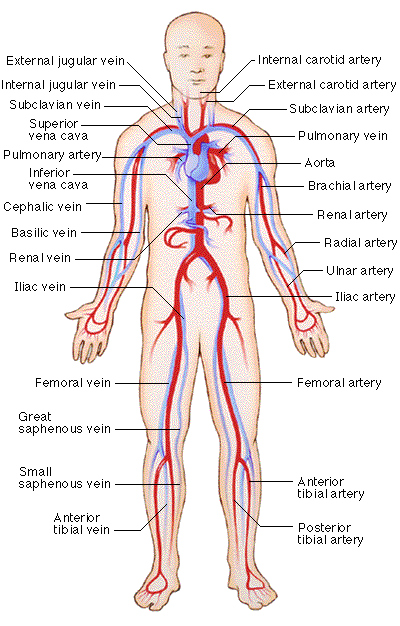
The Circulatory System; Three Dimension Fractal Geometry
Cro-Magnon Man were the first human beings. There is an enormous gap between Cro-Magnon man and Neanderthal. Some Cro-Magnons were over six feet tall, with a cranial capacity somewhat larger than our own. They were normal people, not monkeys, and they provide no evidence of transition from ape to man.

The Big Bang
The Big Bang without Divine control, are you willing to bet your life on it? How could a watch(the universe) come about through a random process? In order to make a watch from an explosion(the big bang), it would have to be a controlled explosion. We all live in a clock-work universe. There are no explanations in how something as complex as a watch could happen through a random process, in fact, the very thought is illogical.
Then there is the problem of where did all the mass within the universe come from? How can something evolve from nothing?
![]()
The human body and DNA
![]()
A Model of DNA
DNA is in all living things. Everything within the physical body is described within its DNA.The human body is a wondrous machine. As you have learned in a previous chapter, the human body has fractal geometry all throughout it, the brain, circulatory system, and nervous system. It also means that three dimensional fractal geometry is programmed into DNA as well. Fractals are predetermined because they are based on mathematics.A 'random' process cannot account for the complexity of DNA.
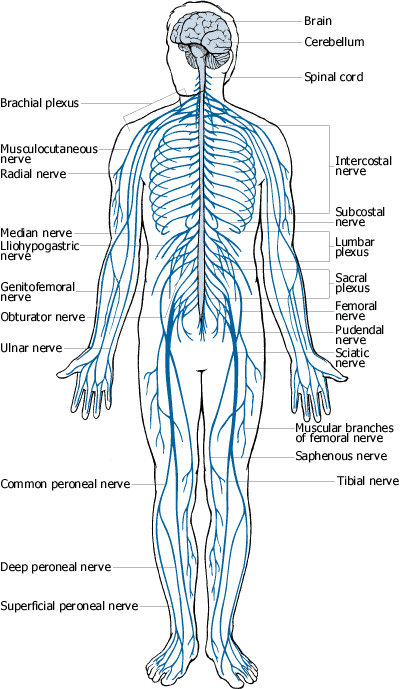
The Nervous System; three dimensional fractal geometry
If you pay attention to educational shows on television, sooner or later you will be made aware that animals which are mentioned do not fit in with Evolution. Evolutionists themselves state that certain animals haven't changed. They say these animals appear suddenly and have maintained their shape all through history, such as the turtle. This brings us to the next section.

ANIMALS THAT PROVE CREATION
A fundamental concept of the theory of evolution is that of gradual change from a "primitive," less complex organism into a highly structured organism over an imagined period of millions of years.
How valid is this idea? Can we really verify the evidence supporting this idea? There are many animals existing today that totally defies evolution by their very existence. This chapter will give examples of some of these animals and explain the problems they give the theory of evolution.The logical frame of reference used in concluding that these animals could not have been the product of evolution is called an indirect proof. The way this works is to assume the opposite of what you wish to prove, proceed logically until you reach a contradiction or an impasse, then conclude that the alternative is true. In this chapter, we will use the concept of indirect proof with evolution, proceed logically until we reach an dead end, leaving creation as the only other alternative.
The realization that each animal is an interdependent, interrelated system was the greatest factor that influenced me to believe that evolution could not have occurred. To survive in a particular environment, an animal has to have features that work in that environment. For example, air breathing animals needs lungs. Flying creatures need wings. If evolution is valid, transitions from one
environment to another had to have occurred. If such transitions are impossible, evolution is impossible!Gradual evolutionary change from one species to another requires many mutations and genetic changes. But, the fossil record exhibits anything but gradual change. There is a gap between living systems and non-life, invertebrates and vertebrates, fish and amphibians, amphibians and reptiles, reptiles and birds, reptiles and mammals, and mammals and man.
Dolphins and Whales
We can demonstrate one such transition problem by using the example of dolphins and whales. These mammals bear their young alive and breathe air, yet spend their entire lifetime in the sea.
Presumably, in order for dolphins and whales to have evolved, they must have originated from a land mammal that returned to the water and changed into a sea creature. But dolphins and whales have so many remarkable features upon which their survival depends that they couldn't have evolved! It would be a lot like trying to change a bus into a submarine one part at a time, all the while it is traveling at 60 miles per hour.

The following is a list of transitions evolutionists have to account for in the dolphin in its evolution from some unknown land dwelling pre-dolphin:
× The nose would have to move to the back of the head.Feet, claws, or tail would be exchanged for fins and flippers.
× It would have to develop a torpedo shaped body for efficient swimming in the water.
× It would have to drink sea water and desalinize it.
× It's entire bone structure and metabolism would have to be rearranged.
× It would need to develop a sophisticated sonar system to search for food.
Could the dolphin acquire these features gradually one at a time over a period of millions of years? What about the transitional stages? Would they have survived with just some of these features?
Why is there a total absence of transitional forms fossilized?Consider the whale and its enormous size in comparison with the plankton it feeds upon. The whale is a nautical vacuum cleaner, with a baleen filter. While it was "developing" this feature, what did it feed upon before? For me, it takes a great stretch of the imagination to picture the evolution of dolphins and whales.
The Duckbill Platypus
The explorer who first saw a hide of the duckbill platypus thought that it was composed of the hides of several different animals sewn together as a joke. Later, when a preserved specimen was brought to him for dissection, he finally declared it outrageous, but genuine!

The more you study the duckbill platypus, the more problems you find for evolutionists. Here is a list of some of its features:(REFERENCE; Brown, Colin. "The Monotremes." Creation Research Society Quarterly. 18:4. March 1982. pp. 187-189.
× It is a furbearing mammal.
× It lays eggs, yet suckles its young.
× It has a ducklike bill, which has built within it a heat sensitive worm finding radar.
× Its tail is flat like a beaver's, yet furry.
× It has webbed feet in front, clawed feet in the rear.
× The reproductive systems are uniquely different from the rest of the animal world, but mostly mammalian in nature.
× The only other known monotreme, or egg-laying mammal is echidna or spiny anteater. Except for the fact that it lays eggs, it is about as different as you can get from the platypus.
Can you imagine what a pre-platypus might have looked like? Nothing in the fossil record gives us a clue about the origin of this animal, which is an outrage to evolutionists. This animal does very well in its natural environment in spite of its unusual features. To look at it, it would appear that this animal was pieced together from a variety of completely different animals.
The Koala
Koalas are marsupials that spend nearly their entire lives high in eucalyptus trees. Their diet consists of eucalyptus leaves toxic to humans. They survive without drinking water or shelter, survive high temperatures by panting, and a well insulated coat protects them from the cold. REFERENCE; Martin, Kelly J. and Smith, E. Norbert. "The Koala - An Evolutionist's Dilemma." Creation Research Society Quarterly. 18:3. December 1981. p. 139.
One of the greatest "advances" of man according to the theory of evolution is the grasping hand with the opposable thumb. But, many apes also have a foot with an opposable great toe. Not to be outdone, the koala not only has an opposable great toe, but two opposable digits on each hand.
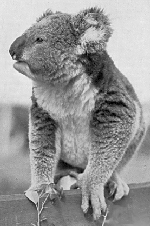
Now, also, the first digit of the foot lacks claws, but the second has two claws! Consider the evolutionist's argument for a claw to migrate from one toe to another over eons of time! One might imagine a double mutation, one that would delete a gene from one place and paste it elsewhere, or you could just believe that the koala was created that way. This would be like a baby born without a fingernail on the index finger, but two fingernails on the middle finger.
What about the unique pouch that opens aft? This feature is similar to that of the wombat, which is a completely different animal than the koala. What could the ancestry of the koala have been to account for these features, especially since transitional forms are missing in the fossils?
Most marsupials are confined to the isolated continent of Australia. Why then is the opossum so widespread in America? It is highly unlikely that one species of marsupial would be so highly removed from its ancestors.
Birds
Proponents of the theory of evolution would have us believe that reptiles began to grow appendages on their back as extensions of scales, and these appendages supposedly developed over periods of millions of years into wings and feathers. Then, they believe that these reptiles began to climb trees and attempted to jump out and fly. Imagine all the ancestral birds attempting to do this until one day one of them had wings structured properly and took off and flew.
There is nothing that is gradual about a transition from a land environment to an air environment, or a land to sea, or sea to land. Such a transition does not take millions of years, either you can fly or you can't; either you breathe air or have gills One of the most complex structures in the animal kingdom is the feather. The feather is lightweight, yet very strong and sturdy. It is made up of a network of fibrils that interconnect with one another in such a way providing the best economy of surface area for the weight. There is a main stem serving as the main support for the feather. It branches out into tributary stems, each of which branches again until they interconnect by using hooks and barbicels.
How would a reptile react to feathers on his back? He'd probably pull them out! Such structures in a transitional form would be detrimental to a reptile.
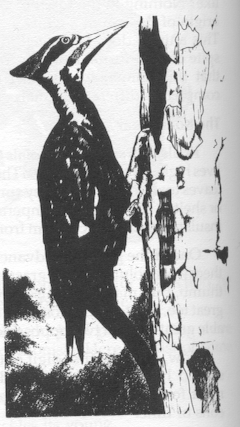
Some birds have unique structures that enable them to perform specialized functions in nature.
REFERENCE Sunderland, Luther D. "Miraculous Design In Woodpeckers" Creation Research Society Quarterly. 12:4. March 1976. p. 183.
REFERENCE Parker, Gary E. The Strange Case of the Woodpecker. (video) Creation-Life Publishers, San Diego, CA 92115.
The woodpecker is such an example. He has special shock absorbers in his beak and skull providing protection from the severe migraine headaches that might otherwise result from his hazardous occupation.
Imagine all the poor pre-woodpeckers knocking themselves out, getting their beaks stuck in trees until this feature "evolved." Most birds have three toes in front and one behind. The woodpecker has two in front and two behind to enable him to grasp onto the side of a tree and peck away. He also has stiff tail feathers to support him and a long sticky tongue designed for fishing the insects he feeds on out of the holes he pecks in the trees. We have to conclude, God designed him for his special occupation.
Consider the water ouzel, a bird that not only flies in the air, but swims underwater with his wings!5 He also strolls on the bottom of the stream, overturning rocks with his beak and toes to feed on various water creatures. Air sacs provide buoyancy, enabling him to rise to the surface. He "blows his tanks" to submerge. Since he does not have webbed feet, he uses his wings as underwater oars.
He normally makes his nest behind a waterfall, through which he must pass to reach his front door. He makes his nest out of living moss, which is kept alive from the spray of the cascade.
How many eons of diving school did this bird endure before he mastered the delicate balance of the air and water environments? These unique air sacs will either work, or they won't. These functions would have to be perfected before our skinnydipping friend would ever discover the juicy morsels on the bottom of the stream.
Bird migration poses a problem for evolutionists. How does one account for birds like the Arctic tern that migrates from pole to pole, and returns to the same nesting spot each year? How does one account for this apparent design if we rule out creation by God?
The Phalarope is a bird who doesn't follow the normal pattern where the male gathers the food and the female sits on the eggs. Instead, it is the male who has to assume all the housewifely chores of nest building, incubation, and family feeding. Only one of two options is available: either juggling of the genders existed from the beginning or "Mother Nature" had to experiment with some bizarre transitional match making. RERFERENCE; Keithley, Willis E. "No Hope for the Phalarope." Creation Research Society Quarterly. 15:1. June, 1978. p. 46.
Consider, though, the broader picture. What was the origin of sex and the roles each sex plays? Courtship behavior, sex roles and reproductive activity vary almost from species to species. This is an indicator of special creation. When did the two sexes diverge? According to evolution, a long slow process over millions of years created the sexes. But, reproduction is either asexual or sexual, there is no in-between. Even if some mutation created a male sexual creature, it would not reproduce unless the same mutation occurred in matching female as well!
Hmmmmmmmmm!!

The smallest bird in nature, and one of the most amazing is the hummingbird.7 Weighing only 1/14 of an ounce, he has much in common with a helicopter, flying backward and sideways and hover in midair. Its rate of metabolism is so high that it must feed almost constantly. But, since there are no rods in the hummingbird's retina for night vision, its vital processes shut down to a state of hibernation at night. The nest of the hummingbird is not much bigger than a postage stamp, made out of thistledown and cobwebs. But, built into this pintsized bird is one of the most complex flight mechanisms known.
Consider the following:
× In the feathers, the quill is considered stronger for its weight than any structure designed by man.
× Flexibility of the quill allows the primary feathers at the wing tip to bend upward with each downbeat of the wing. This produces the equivalent of pitch in a helicopter.
× The quill constantly changes shape to meet the requirements of air pressure and wing position.
× The leading vane of the feather is narrower than the trailing vane. This feature causes the wing to operate like a propeller to give both lift and propulsion.
× The wing is an efficient doublejointed foresail, the inner half sloping at a slight angle to give lift like the wing of an airplane, while the outer half acts like a propeller.
× There is a jet assisted takeoff mechanism. A tuft of feathers at the junction of the wing adds extra airfoil surface during landing and takeoff.
× Enlarged muscles to operate the wings; almost 3/4 the weight of the bird.
× Higher metabolism, temperature, blood pressure, and a hyperactive heart contribute to the bird's success.
× A remarkable system of respiration where the hollow bones provide an air sac system, providing buoyancy, a reservoir for respiration and an air conditioner.
× Air flows into the lungs in only one direction, providing a continuous supply of oxygen.
× Other features: streamlining, retractable landing gear, camouflage, migration navigation, and hibernation.
It is unreasonable to suggest that the hummingbird "developed" all of these features as a product of evolution gradually over millions of years. Time and chance cannot produce such design and order. Only God can!
Another Fishy Story!
The Anableps is a fish that spends his life on the surface of the water. Although he is a rather small fish, he poses a big problem for evolutionists. You see, his eyes are divided in half, the top designed for seeing in air out of the water, and the bottom for seeing below the surface of the water.8 What were the transitional forms like? What kind of evolutionary "pressure" could have caused half an eye to gradually evolve to see out of the water?
The Archer Fish
The Archer fish overcomes a problem in sea to air ballistics. He squirts water at his prey, which are bugs and flies. His mouth has a built in groove that channels the water like a squirt gun. But the biggest problem is his aim. He has to overcome the refractive difference from water to air in order to accurately hit his prey. If you ever looked at a spoon in a glass of water, you would understand the problem. The refractive quality of water makes it appear to be broken in half. Again we marvel at God's design.
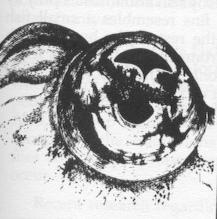
A Fish Goes Fishing!
Consider the angler fish, who has an appendage dangling in front of his mouth that attracts other fish, and when the prey gets close enough, chomp!
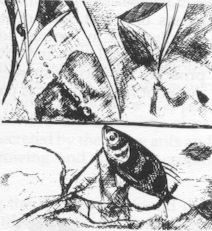
The angler fish lives at great depths and has to handle a lot of water pressure. But the biggest problem for evolutionists is the fact that the male of the species doesn't eat! By an amazing process, he attaches himself to the female, and the blood streams of the two merge! Imagine the changes the male would have had to go through in order to evolve this gradually over a period of millions of years!
Creation Wins By A Neck
Have you ever wondered why the giraffe's brain doesn't explode when he stoops to get a drink of water? Or, why he doesn't pass out when he raises his head back up again? It's because God has specially created valves in his neck which close off the enormous flow of blood needed to raise it to the giraffe's great height. REFERENCE; Davis, Percival, and Kenyon, Dean. Of Pandas and People, Second Edition. Haughton Publishing Co. Dallas, TX. p. 69-72.
The giraffe has a powerful heart almost two feet long to make sure the blood supply gets to his brain. But if he did not have the special valves in his arteries which regulate his blood supply, his brains would explode under the pressure. Also, there is a special sponge underneath the giraffe's brain which absorbs the last pump of blood. Now, when he raises back up, that sponge squeezes that oxygenated blood into his brain, the valves open up, and he doesn't pass out.
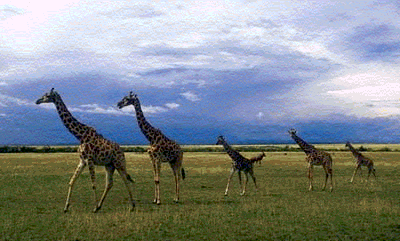
Now, could this mechanism have evolved? No way! If the first giraffe had a long neck and two foot long heart, but no mechanism to regulate it, when he first stooped to get a drink of water, he would have blown his mind. Then, after he had blown his mind, he would have thought to himself, "I need to evolve valves in my arteries to regulate this!" No, he would have been dead! The giraffe's long neck couldn't have evolved; it needed to be completely functional in the first place.
QUESTIONS FOR STUDY
1. Describe briefly the logic used in this chapter to show how certain animals do not fit the theory of Evolution.
2. List several of these animals and their unique traits that confound evolutionists.
3. What are some of the major environmental transitions the theory of Evolution has to explain?
4. Would "transitional forms" between animals in existence today have survived?
5. Using the same indirect proof logic, describe an animal not mentioned in this chapter that presents the same kind of problems for evolutionists.

Evolutionists Speak out about their Theory.
Part One
Top-flight scientists have something to tell you about evolution. Such statements will never be found in the popular magazines, alongside gorgeous paintings of ape-man and Big Bangs and solemn pronouncements about millions of years for this rock and that fish. Instead they are generally reserved only for professional books and journals.
Most scientists are working in very narrow fields; they do not see the overall picture, and assume, even though their field does not prove evolution, that perhaps other areas of science probably vindicate it. They are well-meaning men. The biologists and geneticists know their facts, and research does not prove evolution, but assume that geology does. The geologists know their field does not prove evolution, but hope that the biologists and geneticists have proven it. Those who do know the facts, fear to disclose them to the general public, lest they be fired. But they do write articles in their own professional journals and books, condemning evolutionary theory.
Included below are a number of admissions by leading evolutionists of earlier decades, such as *Charles Darwin, *Austin Clark, or *Fred Hoyle. The truth is that evolutionists cannot make scientific facts fit the theory.
An asterisk ( * ) by a name indicates that person is not known to be a creationist.
"The Darwinian theory of descent has not a single fact to confirm it in the realm of nature. It is not the result of scientific research, but purely the product of imagination."—*Dr. Fleischman [Erlangen zoologist].
"It is almost invariably assumed that animals with bodies composed of a single cell represent the primitive animals from which all others derived. They are commonly supposed to have preceded all other animal types in their appearance. There is not the slightest basis for this assumption."—*Austin Clark, The New Evolution (1930), pp. 235-236.
"The hypothesis that life has developed from inorganic matter is, at present, still an article of faith."—*J.W.N. Sullivan, The Limitations of Science (1933), p. 95.
"Where are we when presented with the mystery of life? We find ourselves facing a granite wall which we have not even chipped . . We know virtually nothing of growth, nothing of life."—*W. Kaempffert, "The Greatest Mystery of All: The Secret of Life," New York Times.
" `The theory of evolution is totally inadequate to explain the origin and manifestation of the inorganic world.' "—Sir John Ambrose Fleming, F.R.S., quoted in H. Enoch, Evolution or Creation (1966), p. 91 [discoverer of the thermionic valve].
"I think, however, that we must go further than this and admit that the only acceptable explanation is creation. I know that this is anathema to physicists, as indeed it is to me, but we must not reject a theory that we do not like if the experimental evidence supports it."—*H. Lipson, "A Physicist Looks at Evolution," Physics Bulletin, 31 (1980), p. 138.
"I am not satisfied that Darwin proved his point or that his influence in scientific and public thinking has been beneficial . . the success of Darwinism was accomplished by a decline in scientific integrity."—*W.R. Thompson, Introduction to *Charles Darwin's, Origin of the Species [Canadian scientist].
"One of the determining forces of scientism was a fantastic accidental imagination which could explain every irregularity in the solar system without explanation, leap the gaps in the atomic series without evidence [a gap required by the Big Bang theory], postulate the discovery of fossils which have never been discovered, and prophesy the success of breeding experiments which have never succeeded. Of this kind of science it might truly be said that it was `knowledge falsely so called.' "—*David C.C. Watson, The Great Brain Robbery (1976).
"The hold of the evolutionary paradigm [theoretical system] is so powerful that an idea which is more like a principle of medieval astrology than a serious twentieth century scientific theory has become a reality for evolutionary biologists."—*Michael Denton, Evolution: A Theory in Crisis (1985), p. 306 [Australian molecular biologist].
"The particular truth is simply that we have no reliable evidence as to the evolutionary sequence . . One can find qualified professional rguments for any group being the descendant of almost any other."—J. Bonner, "Book Review," American Scientist, 49:1961, p. 240.
"It was because Darwinian theory broke man's link with God and set him adrift in a cosmos without purpose or end that its impact was so fundamental. No other intellectual revolution in modern times . . so profoundly affected the way men viewed themselves and their place in the universe."—*Michael Denton, Evolution: A Theory in Crisis (1985), p. 67 [Australian molecular biologist].
"I had motives for not wanting the world to have meaning, consequently assumed it had none, and was able without any difficulty to find satisfying reasons for this assumption . . The philosopher who finds no meaning in the world is not concerned exclusively with a problem in pure metaphysics; he is also concerned to prove there is no valid reason why he personally should not do as he wants to do . . For myself, as no doubt for most of my contemporaries, the philosophy of meaninglessness was essentially an instrument of liberation. The liberation we desired was simultaneously liberation from a certain political and economic system and liberation from a certain system of morality. We objected to the morality because it interfered with our sexual freedom."—*Aldous Huxley, "Confessions of a Professed Atheist," Report: Perspective on the News, Vol. 3, June 1966, p. 19 [grandson of evolutionist Thomas Huxley, Darwin's closest friend and promoter, and brother of evolutionist Julian Huxley. Aldous Huxley was one of the most influential liberal writers of the 20th century].
"Evolutionism is a fairy tale for grown-ups. This theory has helped nothing in the progress of science. It is useless."—*Bounoure, Le Monde Et La Vie (October 1963) [Director of Research at the National center of Scientific Research in France].
"As by this theory, innumerable transitional forms must have existed. Why do we not find them embedded in the crust of the earth? Why is not all nature in confusion [of halfway species] instead of being, as we see them, well-defined species?"—*Charles Darwin, quoted in H. Enoch, Evolution or Creation (1966), p. 139.
" `Creation,' in the ordinary sense of the word, is perfectly conceivable. I find no difficulty in conceiving that, at some former period, this universe was not in existence; and that it made its appearance in six days . . in consequence of the volition of some pre-existing Being."—*Thomas Huxley, quoted in *Leonard Huxley, Life and Letters of Thomas Henry Huxley, Vol. II (1903), p. 429.
"The theory of evolution suffers from grave defects, which are more and more apparent as time advances. It can no longer square with practical scientific knowledge."—*Albert Fleishmann, Zoologist.
"I argue that the `theory of evolution' does not take predictions, so far as ecology is concerned, but is instead a logical formula which can be used only to classify empiricisms [theories] and to show the relationships which such a classification implies . . these theories are actually tautologies and, as such, cannot make empirically testable predictions. They are not scientific theories at all."—*R.H. Peters, "Tautology in Evolution and Ecology," American Naturalist (1976), Vol. 110, No. 1, p. 1 [emphasis his].
"Scientists have no proof that life was not the result of an act of creation."—*Robert Jastrow, The Enchanted Loom: Mind in the Universe (1981), p. 19.
"In fact, evolution became in a sense a scientific religion; almost all scientists have accepted it and many are prepared to `bend' their observations to fit in with it."—*H. Lipson, "A Physicist Looks at Evolution," Physics Bulletin, 31 (1980), p. 138.
"When Darwin presented a paper [with Alfred Wallace] to the Linnean Society in 1858, a Professor Haugton of Dublin remarked, `All that was new was false, and what was true was old.' This, we think, will be the final verdict on the matter, the epitaph on Darwinism."—*Fred Hoyle and N. Chandra Wickramasinghe, Evolution from Space (1981), p. 159.
"Creation and evolution, between them, exhaust the possible explanations for the origin of living things. Organisms either appeared on the earth fully developed or they did not. If they did not, they must have developed from pre-existing species by some process of modification. If they did appear in a fully developed state, they must have been created by some omnipotent intelligence."—*D.J. Futuyma, Science on Trial (1983), p. 197.
"With the failure of these many efforts, science was left in the somewhat embarrassing position of having to postulate theories of living origins which it could not demonstrate. After having chided the theologian for his reliance on myth and miracle, science found itself in the unenviable position of having to create a mythology of its own: namely, the assumption that what, after long effort, could not be proved to take place today had, in truth, taken place in the primeval past."—*Loren Eisley, The Immense Journey, (1957), p. 199.
"The over-riding supremacy of the myth has created a widespread illusion that the theory of evolution was all but proved one hundred years ago and that all subsequent biological research—paleontological, zoological, and in the newer branches of genetics and molecular biology—has provided ever-increasing evidence for Darwinian ideas."—*Michael Denton, Evolution: A Theory in Crisis (1985), p. 327.
"The irony is devastating. The main purpose of Darwinism was to drive every last trace of an incredible God from biology. But the theory replaces God with an even more incredible deity—omnipotent chance."—*T. Rosazak, Unfinished Animal (1975), pp. 101-102.
"Today our duty is to destroy the myth of evolution, considered as a simple, understood and explained phenomenon which keeps rapidly unfolding before us. Biologists must be encouraged to think about the weaknesses and extrapolations that the theoreticians put forward or lay down as established truths. The deceit is sometimes unconscious, but not always, since some people, owing to their sectarianism, purposely overlook reality and refuse to acknowledge the inadequacies and falsity of their beliefs."—*Pierre-Paul de Grasse, Evolution of Living Organisms (1977), p. 8.
"The evolution theory can by no means be regarded as an innocuous natural philosophy, but that it is a serious obstruction to biological research. It obstructs—as has been repeatedly shown—the attainment of consistent results, even from uniform experimental material. For everything must ultimately be forced to fit this theory. An exact biology cannot, therefore, be built up."—*H. Neilsson, Synthetische Artbuilding, 1954, p. 11.
"It is therefore of immediate concern to both biologists and layman that Darwinism is under attack. The theory of life that undermined nineteenth-century religion has virtually become a religion itself and, in its turn, is being threatened by fresh ideas. The attacks are certainly not limited to those of the creationists and religious fundamentalists who deny Darwinism for political and moral reason. The main thrust of the criticism comes from within science itself. The doubts about Darwinism represent a political revolt from within rather than a siege from without."—*B. Leith, The Descent of Darwin: A Handbook of Doubts about Darwinism (1982), p. 11.
"My attempts to demonstrate evolution by an experiment carried on for more than 40 years have completely failed. At least I should hardly be accused of having started from any preconceived anti-evolutionary standpoint."—*H. Nilsson, Synthetic Speciation (1953), p. 31.
"Just as pre-Darwinian biology was carried out by people whose faith was in the Creator and His plan, post-Darwinian biology is being carried out by people whose faith is in, almost, the deity of Darwin. They've seen their task as to elaborate his theory and to fill the gaps in it, to fill the trunk and twigs of the tree. But it seems to me that the theoretical framework has very little impact on the actual progress of the work in biological research. In a way some aspects of Darwinism and of neo-Darwinism seem to me to have held back the progress of science."—Colin Patterson, The Listener [senior paleontologist at the British Museum of Natural History, London].
"Throughout the past century there has always existed a significant minority of first-rate biologists who have never been able to bring themselves to accept the validity of Darwinian claims. In fact, the number of biologists who have expressed some degree of disillusionment is practically endless."—*Michael Denton, Evolution: A Theory in Crisis (1986), p. 327.
"I personally hold the evolutionary position, but yet lament the fact that the majority of our Ph.D. graduates are frightfully ignorant of many of the serious problems of the evolution theory. These problems will not be solved unless we bring them to the attention of students. Most students assume evolution is proved, the missing link is found, and all we have left is a few rough edges to smooth out. Actually, quite the contrary is true; and many recent discoveries . . have forced us to re-evaluate our basic assumptions."—*Director of a large graduate program in biology, quoted in Creation: The Cutting Edge (1982), p. 26.
"The creation account in Genesis and the theory of evolution could not be reconciled. One must be right and the other wrong. The story of the fossils agreed with the account of Genesis. In the oldest rocks we did not find a series of fossils covering the gradual changes from the most primitive creatures to developed forms, but rather in the oldest rocks developed species suddenly appeared. Between every species there was a complete absence of intermediate fossils."—*D.B. Gower, "Scientist Rejects Evolution," Kentish Times, England, December 11, 1975, p. 4 [biochemist].
"From the almost total absence of fossil evidence relative to the origin of the phyla, it follows that any explanation of the mechanism in the creative evolution of the fundamental structural plans is heavily burdened with hypothesis. This should appear as an epigraph to every book on evolution. The lack of direct evidence leads to the formulation of pure conjecture as to the genesis of the phyla; we do not even have a basis to determine the extent to which these opinions are correct."—*Pierre-Paul de Grasse, Evolution of Living Organisms (1977), p. 31.
"We still do not know the mechanics of evolution in spite of the over-confident claims in some quarters, nor are we likely to make further progress in this by the classical methods of paleontology or biology; and we shall certainly not advance matters by jumping up and down shrilling, `Darwin is god and I, So-and-so, am his prophet.' "—*Errol White, Proceedings of the Linnean Society, London, 177:8 (1966).
"I feel that the effect of hypotheses of common ancestry in systematics has not been merely boring, not just a lack of knowledge; I think it has been positively anti-knowledge . . Well, what about evolution? It certainly has the function of knowledge, but does it convey any? Well, we are back to the question I have been putting to people, `Is there one thing you can tell me about?' The absence of answers seems to suggest that it is true, evolution does not convey any knowledge."—*Colin Patterson, Director AMNH, Address at the American Museum of Natural History (November 5, 1981).
"What is it [evolution] based upon? Upon nothing whatever but faith, upon belief in the reality of the unseen—belief in the fossils that cannot be produced, belief in the embryological experiments that refuse to come off. It is faith unjustified by works."—*Arthur N. Field.

Part Two
There are scientists all over the world who know that evolutionary theory is bankrupt. Such men as *Charles Darwin, *Thomas and *Julian Huxley, and *Steven Jay Gould have admitted it. But you will not find these statements in the popular press. Such admissions are only made to fellow professionals.
An asterisk ( * ) by a name indicates that person is not known to be a creationist.
"Paleontologists [fossil experts] have paid an exorbitant price for Darwin's argument. We fancy ourselves as the only true students of life's history, yet to preserve our favored account of evolution by natural selection we view our data as so bad that we almost never see the very process we profess to study."—*Steven Jay Gould, The Panda's Thumb (1982), pp. 181-182 [Harvard professor and the leading evolutionary spokesman of the latter half of the twentieth century].
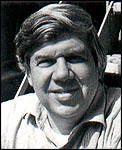
Steven Jay Gould
"The problem of the origin of species has not advanced in the last 150 years. One hundred and fifty years have already passed during which it has been said that the evolution of the species is a fact but, without giving real proofs of it and without even a principle of explaining it. During the last one hundred and fifty years of research that has been carried out along this line [in order to prove the theory], there has been no discovery of anything. It is simply a repetition in different ways of what Darwin said in 1859. This lack of results is unforgivable in a day when molecular biology has really opened the veil covering the mystery of reproduction and heredity . . "Finally, there is only one attitude which is possible as I have just shown: It consists in affirming that intelligence comes before life. Many people will say this is not science, it is philosophy. The only thing I am interested in is fact, and this conclusion comes out of an analysis and observation of the facts."—*G. Salet, Hasard et Certitude: Le Transformisme devant la Biologie Actuelle (1973), p. 331.
"The theories of evolution, with which our studious youth have been deceived, constitute actually a dogma that all the world continues to teach; but each, in his specialty, the zoologist or the botanist, ascertains that none of the explanations furnished is adequate . . It results from this summary, that the theory of evolution is impossible."—*P. Lemoine, "Introduction: De L' Evolution?" Encyclopedie Francaise, Vol. 5 (1937), p. 6.
"Darwinism is a creed not only with scientists committed to document the all-purpose role of natural selection. It is a creed with masses of people who have at best a vague notion of the mechanism of evolution as proposed by Darwin, let alone as further complicated by his successors. Clearly, the appeal cannot be that of a scientific truth but of a philosophical belief which is not difficult to identify. Darwinism is a belief in the meaninglessness of existence."—*R. Kirk, "The Rediscovery of Creation," in National Review, (May 27, 1983), p. 641.
"I have always been slightly suspicious of the theory of evolution because of its ability to account for any property of living beings (the long neck of the giraffe, for example). I have therefore tried to see whether biological discoveries over the last thirty years or so fit in with Darwin's theory. I do not think that they do. To my mind, the theory does not stand up at all."—*H. Lipson, "A Physicist Looks at Evolution," Physic Bulletin, 31 (1980), p. 138.
"Evolution is baseless and quite incredible."—*John Ambrose Fleming, President, British Association for Advancement of Science, in The Unleashing of Evolutionary Thought.
"Unfortunately, in the field of evolution most explanations are not good. As a matter of fact, they hardly qualify as explanations at all; they are suggestions, hunches, pipe dreams, hardly worthy of being called hypotheses."—*Norman Macbeth, Darwin Retried (1971), p. 147.
"It is not the duty of science to defend the theory of evolution, and stick by it to the bitter end—no matter which illogical and unsupported conclusions it offers. On the contrary, it is expected that scientists recognize the patently obvious impossibility of Darwin's pronouncements and predictions . . Let's cut the umbilical cord that tied us down to Darwin for such a long time. It is choking us and holding us back."—I.L. Cohen, Darwin Was Wrong: A Study in Probabilities (1985).
"This general tendency to eliminate, by means of unverifiable speculations, the limits of the categories Nature presents to us, is the inheritance of biology from The Origin of Species. To establish the continuity required by theory, historical arguments are invoked, even though historical evidence is lacking. Thus are engendered those fragile towers of hypothesis based on hypothesis, where fact and fiction intermingle in an inextricable confusion."—*W.R. Thompson, "Introduction," to Everyman's Library issue of *Charles Darwin's, Origin of Species (1956 edition).
" `Scientists who go about teaching that evolution is a fact of life are great con men, and the story they are telling may be the greatest hoax ever. In explaining evolution we do not have one iota of fact.' A tangled mishmash of guessing games and figure juggling [Tahmisian called it]."—*The Fresno Bee, August 20, 1959, p. 1-B [quoting T.N. Tahmisian, physiologist for the Atomic Energy Commission].
" `The theory [of evolution] is a scientific mistake.' "—*Louis Agassiz, quoted in H. Enoch, Evolution or Creation, (1966), p. 139. [Agassiz was a Harvard University professor and the pioneer in glaciation.]
"[In Darwin's writings] possibilities were assumed to add up to probability, and probabilities then were promoted to certitudes."—*Agassiz, op. cit., p. 335.
"The origin of all diversity among living beings remains a mystery as totally unexplained as if the book of Mr. Darwin had never been written, for no theory unsupported by fact, however plausible it may appear, can be admitted in science."—L. Agassiz on the Origin of Species, American Journal of Science, 30 (1860), p. 154. [Darwin's book was published in 1859.]
"[Darwin could] summon up enough general, vague and conjectural reasons to account for this fact, and if these were not taken seriously, he could come up with a different, but equally general, vague and conjectural set of reasons."—*Gertrude Himmelfarb, Darwin and Darwinian Revolution (1968), p. 319.
"Ultimately the Darwinian theory of evolution is no more nor less than the great cosmogenic myth of the twentieth century . . the origin of life and of new beings on earth is still largely as enigmatic as when Darwin set sail on the [ship] Beagle."—*Michael Denton, Evolution: A Theory in Crisis (1986), p. 358.
"It has been estimated that no fewer than 800 phrases in the subjunctive mood (such as `Let us assume,' or `We may well suppose,' etc.) are to be found between the covers of Darwin's Origin of Species alone."—L. Merson Davies [British scientist], Modern Science (1953), p. 7.
"I can envision observations and experiments that would disprove any evolutionary theory I know."—*Stephen Jay Gould, "Evolution as Fact and Theory," Discover 2(5):34-37 (1981).
"Unfortunately for Darwin's future reputation, his life was spent on the problem of evolution which is deductive by nature . . It is absurd to expect that many facts will not always be irreconcilable with any theory of evolution and, today, every one of his theories is contradicted by facts."—*P.T. Mora, The Dogma of Evolution, p. 194.
"Darwinism is a creed not only with scientists committed to document the all-purpose role of natural selection. It is a creed with masses of people who have, at best, a vague notion of the mechanism of evolution as proposed by Darwin, let alone as further complicated by his successors."—*S. Jaki, Cosmos and Creator (1982).
"In essence, we contend that neo-Darwinism is a theory of differential survival and not one of origin . .
"We are certainly not arguing here that differential survival of whole organisms does not occur. This must inevitably happen [i.e. some species become extinct]. The question that we must ask is, does this represent the controlling dynamic of organic evolution? Cannot a similar argument be equally well-constructed to `explain' any frequency distribution? For example, consider rocks which vary in hardness and also persist through time. Clearly the harder rocks are better `adapted' to survive harsh climatic conditions. As Lewontin points out, a similar story can be told about political parties, rumors, jokes, stars, and discarded soft drink containers."—*A.J. Hughes and *D. Lambert, "Functionalism, Structuralism, `Ways of Seeing,' " Journal of Theoretical Biology, 787 (1984), pp. 796-797.
"Biologists have indeed built their advances in evolutionary theory on the Darwinian foundation, not realizing that the foundation is about to topple because of Darwin's three mistakes.
"George Bernard Shaw wisecracked once that Darwin had the luck to please everybody who had an axe to grind. Well, I also have an axe to grind, but I am not pleased. We have suffered through two world wars and are threatened by an Armageddon. We have had enough of the Darwinian fallacy."—*Kenneth Hsu, "Reply," Geology, 15 (1987), p. 177.
"Therefore, a grotesque account of a period some thousands of years ago is taken seriously though it be built by piling special assumptions on special assumptions, ad hoc hypothesis [invented for a purpose] on ad hoc hypothesis, and tearing apart the fabric of science whenever it appears convenient. The result is a fantasia which is neither history nor science."—*James Conant [chemist and former president, Harvard University], quoted in Origins Research, Vol. 5, No. 2, 1982, p. 2.
"It is inherent in any definition of science that statements that cannot be checked by observation are not really saying anything—or at least they are not science."—*George G. Simpson, "The Nonprevalence of Humanoids," in Science, 143 (1964) p. 770.
"In accepting evolution as fact, how many biologists pause to reflect that science is built upon theories that have been proved by experiment to be correct or remember that the theory of animal evolution has never been thus approved."—*L.H. Matthews, "Introduction," Origin of Species, Charles Darwin (1971 edition).
"Present-day ultra-Darwinism, which is so sure of itself, impresses incompletely informed biologists, misleads them, and inspires fallacious interpretations . .
"Through use and abuse of hidden postulates, of bold, often ill-founded extrapolations, a pseudoscience has been created. It is taking root in the very heart of biology and is leading astray many biochemists and biologists, who sincerely believe that the accuracy of fundamental concepts has been demonstrated, which is not the case."—*Pierre P. de Grasse, The Evolution of Living Organisms (1977), p. 202.
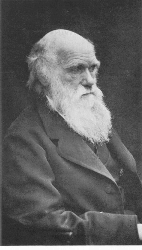
Charles Darwin
[In a letter to Asa Gray, a Harvard professor of biology, Darwin wrote:] "I am quite conscious that my speculations run quite beyond the bounds of true science."—*Charles Darwin, quoted in *N.C. Gillespie, Charles Darwin and the Problem of Creation (1979), p. 2 [University of Chicago book].
"The fact is that the evidence was so patchy one hundred years ago that even Darwin himself had increasing doubts as to the validity of his views, and the only aspect of his theory which has received any support over the past century is where it applies to microevolutionary phenomena. His general theory, that all life on earth had originated and evolved by a gradual successive accumulation of fortuitous mutations, is still, as it was in Darwin's time, a highly speculative hypothesis entirely without direct factual support and very far from that self-evident axiom some of its more aggressive advocates would have us believe."—*Michael Denton, Evolution: A Theory in Crisis (1986), p. 77.

Naturally the anti-Christ would want to steer us away from the truth, while at the same time making arguments for it. This would get people to fight one another, right? Another divide and conquer tactic? YES!
Personally I reject the theory of evolution. I also reject what is being taught in the church, so do not think I am a bible thumper, I am far from it. It just so happens that the bible reflects my beliefs. What I believe in is, the creation of biological life in its final form and that form retaining its shape all throughout its existence.
The bible also reflects an interplanetary involvement with our creation. Both the bible and ancient stories world wide reflect this. And if you take everything in collectively on this web site you will realize "The Revelation.